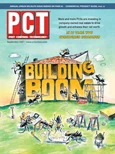Yep! It’s that time of year when many insects have reached a critical point in their development. Most insects that typically live outdoors overwinter in the egg, pupal or adult stage. Few overwinter in the larval or nymph stage because food is unavailable for growth and development; nymphs and larvae don’t accumulate metabolic reserves to see them through the winter; and eggs, pupae and adults are able to get things up and running in the spring.
As fall approaches, pest management professionals are rarely confronted with problems involving immature stages of arthropods — it is the adults seeking harborage for the winter that cause nightmares. These life stages are unable to withstand exposure to the elements during colder months and must seek protected areas until things warm up in the spring. Fortunately, most of these occasional invaders find protection in outdoor areas, such as under the bark of trees, in logs, under landscape timbers, in the soil, etc. Unfortunately, the pests that seek this refuge in your customers’ homes are the ones that will give you nightmares.
The pressure from these invaders is intense, i.e., not only do they have to find suitable winter harborage but at the end of the summer their numbers are at a peak. So, now is the time to proactively address these seasonal invaders. The pest management options for addressing these pests vary depending on the type of pest, how and where they attempt to enter the structure.
LADY BUGS AND CLUSTER FLIES. There is a wide array of flying fall invaders, including stink bugs, plant bugs, elm leaf beetles, boxelder bugs and others; however, the most common, numerous and problematic flying fall invaders are lady bugs (beetles) and cluster flies. They can be found massing on the warmer south and west walls of structures in early fall. Their numbers greatly increase toward the end of the day as the sun sets and cooler evening temperatures prevail.
During the summer, treating plants to minimize lady bug prey, e.g., aphids, lace bugs, white flies, etc., can reduce their numbers in the fall, however, by this time of year these treatments are of no value. Also, don’t discount the customer who says lady bugs bite — they do and it hurts (take it from a victim of many bites).
Unfortunately, source reduction for cluster flies is virtually impossible, since they are obligatory parasites of earthworms and to my knowledge there are no products registered for the control of beneficial earthworms. Because both of these insects are relatively strong fliers, source reduction does nothing to keep them from immigrating in from adjoining properties.
Exclusion, e.g., caulking and sealing around doors, windows, soffits, attic openings and wall penetrations, can prevent some of these insects from entering the structure. While most of this effort should be focused on the exterior in structures that have chronic problems, exclusion on the interior is of some value when the hibernating insects venture out on a warm day.
Frequently both insects will seek harborage around door and window seals, the edges of window screens, attics and other areas that can’t be sealed.
One of the most effective strategies is to treat around points of entry and areas where these insects congregate, preferably when they are present. Pyrethroid microencapsulated formulations are more durable and while they provide direct kill they have added value in repelling these insects. Other formulations are effective but may require reapplication after heavy rain. When these insects emerge inside the best method of removal is vacuuming, glue sticks/boards and light traps. In my opinion, treatment indoors is of no value because it is like looking for needles in a haystack.
Another group of fall invaders don’t fly to the structure — they hop and crawl inside. This group includes field crickets, camel crickets, clover mites, springtails, ground beetles, earwigs, millipedes, house centipedes, sowbugs, ground beetles, etc. Probably the two most disconcerting of the group are the crickets and clover mites.
CRICKETS AND CLOVER MITES. Both of these invaders present unique problems. One male cricket inside a structure can disrupt many nights of sleep as he calls for a mate and there has been many an irate customer who wants that d@$% cricket out now. In contrast, clover mites invade in mass and can be seen trailing inside and outside the structure, up and down the walls and across window sills. They further concern customers because they are “blood” red — the good news is they don’t bite and it is not blood.
Field crickets, in contrast to many of the other pests considered indoor overwintering problems, are short lived indoors. Their typical overwintering stages are as mature nymphs (can’t chirp) or eggs. By the time you read this column, most crickets will have reached maturity and while they may chirp their brains out for several days, they eventually die and no interdiction other than placing some sticky traps is necessary indoors. If mature nymphs are found outdoors it is not too late to bait and most of the baits registered for crickets are effective. Sprays can be used around points of entry, however, I have found baits used in a timely fashion prevent most indoor incursions.
Clover mites, in contrast to crickets, are true overwintering pests and much like lady bugs and cluster flies, they will reemerge on a warm winter day and as many get inside as those getting out. They also have the advantage of getting into the tiniest holes and cracks and crevices.
When these mites emerge indoors they are best eliminated by using small trays of soapy water and/or glueboards. Advise customers not to crush the mites as they will stain fabrics, paint and wallpaper.
Prevention on the exterior is best effected by the application of residual sprays. While the microencapsulated pyrethroids hold up in rain, in my opinion they aren’t the ultimate solution — we have had better luck with other residual sprays. While granules appear to be an option, they haven’t proven to be very effective.
If you are having problems with high rise buildings, e.g., problems on the 12th floor — these mites are not climbing 12 stories to find an overwintering site. Look for a patio or flat roof — this is more likely the source of infestation and these mites can be found year round in these environments. Look under pavers, rubber boots and flashing on the roof and patio — these areas typically support mold growth, a good food source for clover mites. A little shot of bleach to kill the mold and a residual insecticide to kill the mites normally does the trick.
Hopefully when your customer asks who is that knocking at my door, the answer is something with two legs and not four (or more).
The author is president of Innovative Pest Management, Brookeville, Md. He can be reached at 301/570-3900.

Explore the September 2007 Issue
Check out more from this issue and find your next story to read.
Latest from Pest Control Technology
- Moneypenny is a Provider of Virtual Receptionists
- Video: Top 10 PCT Photo Contest Finalists
- Massey Services Expands with Southeast Commercial Region
- Pest Management Foundation Announces Kevin J. Burns Scholarship
- How to Identify Clover Mites
- Termite Threat Halted in Southern Florida
- PCT Media Group Adds Managing Editor Katie Hobbins
- Evens Clerjuste on Team Communication as Company Growth Point





